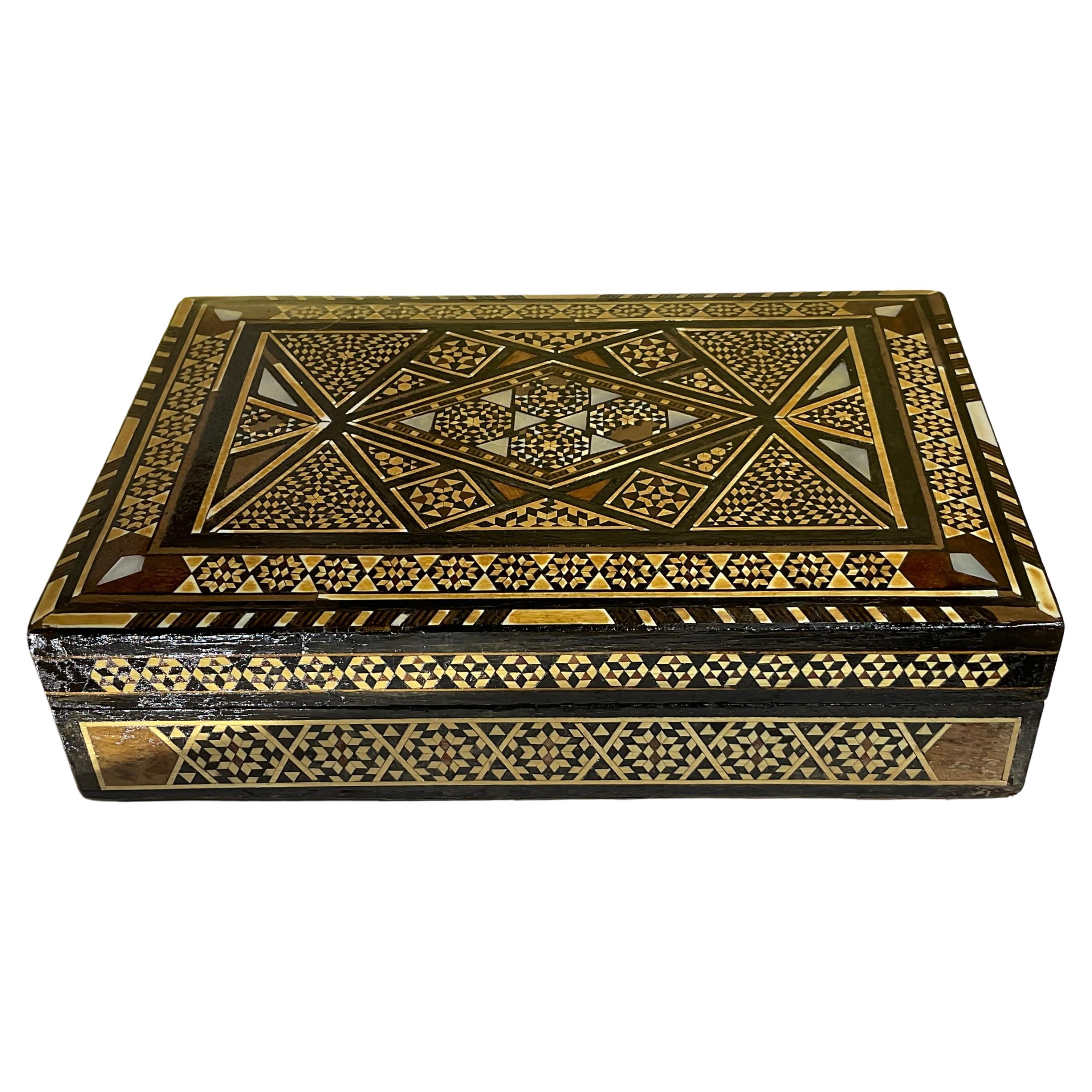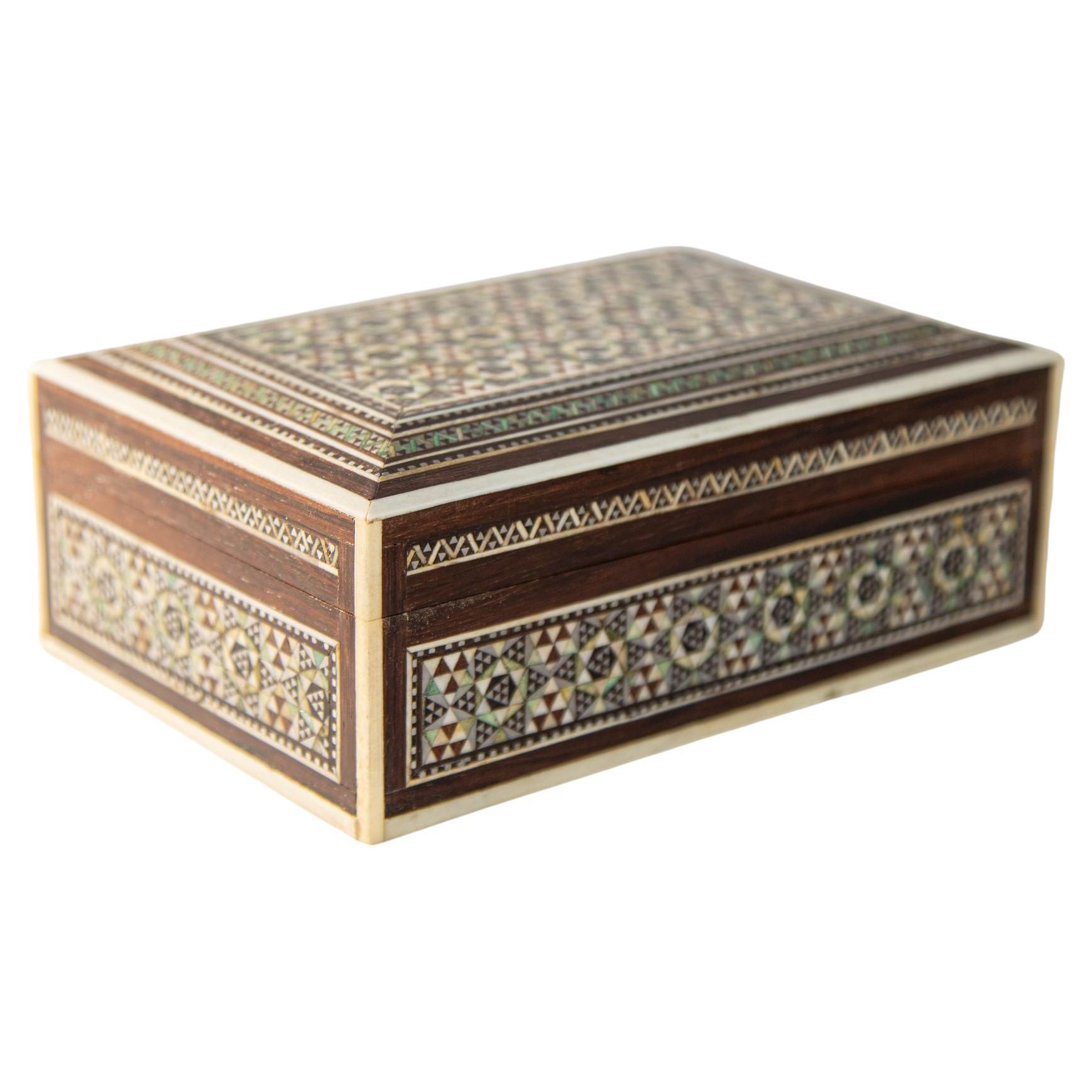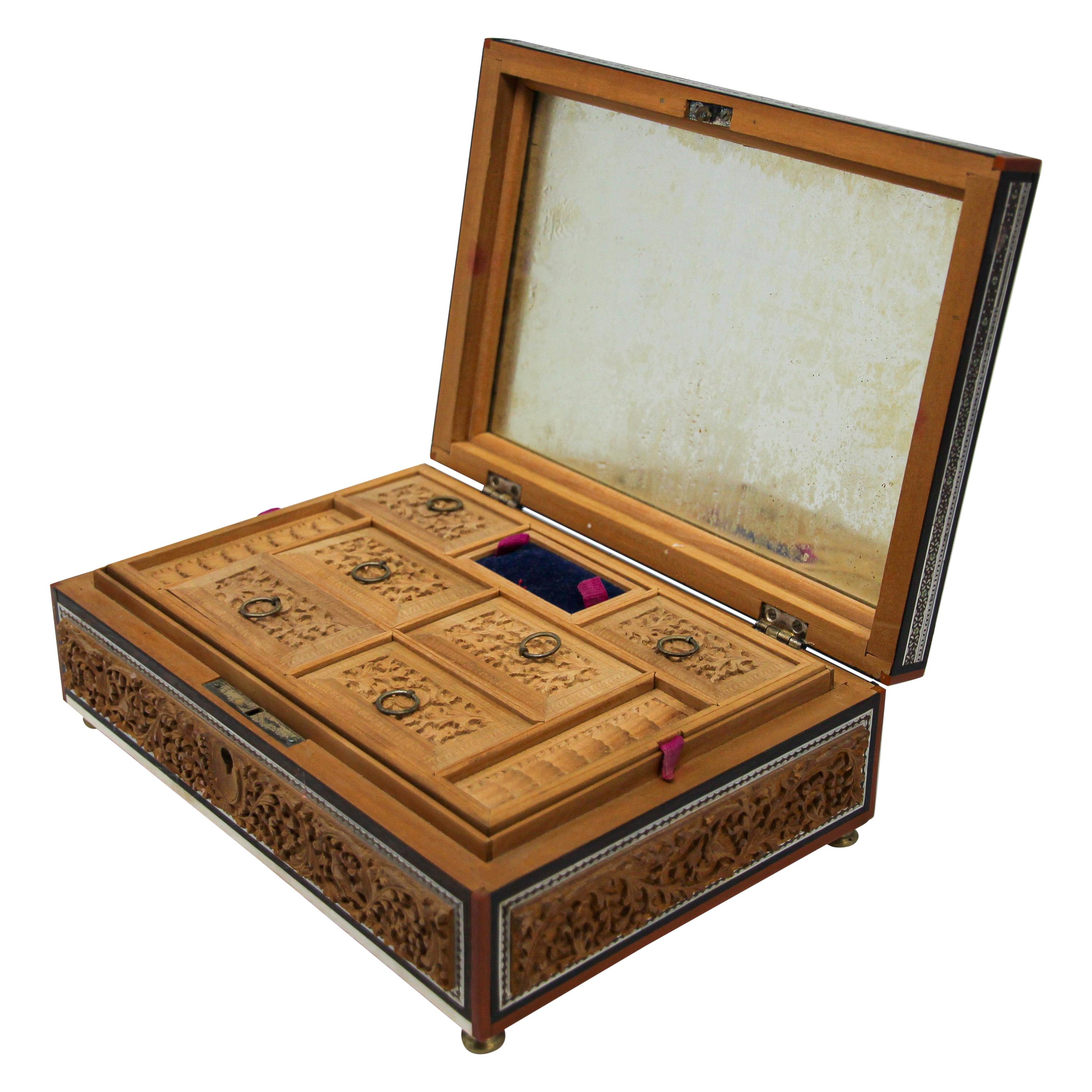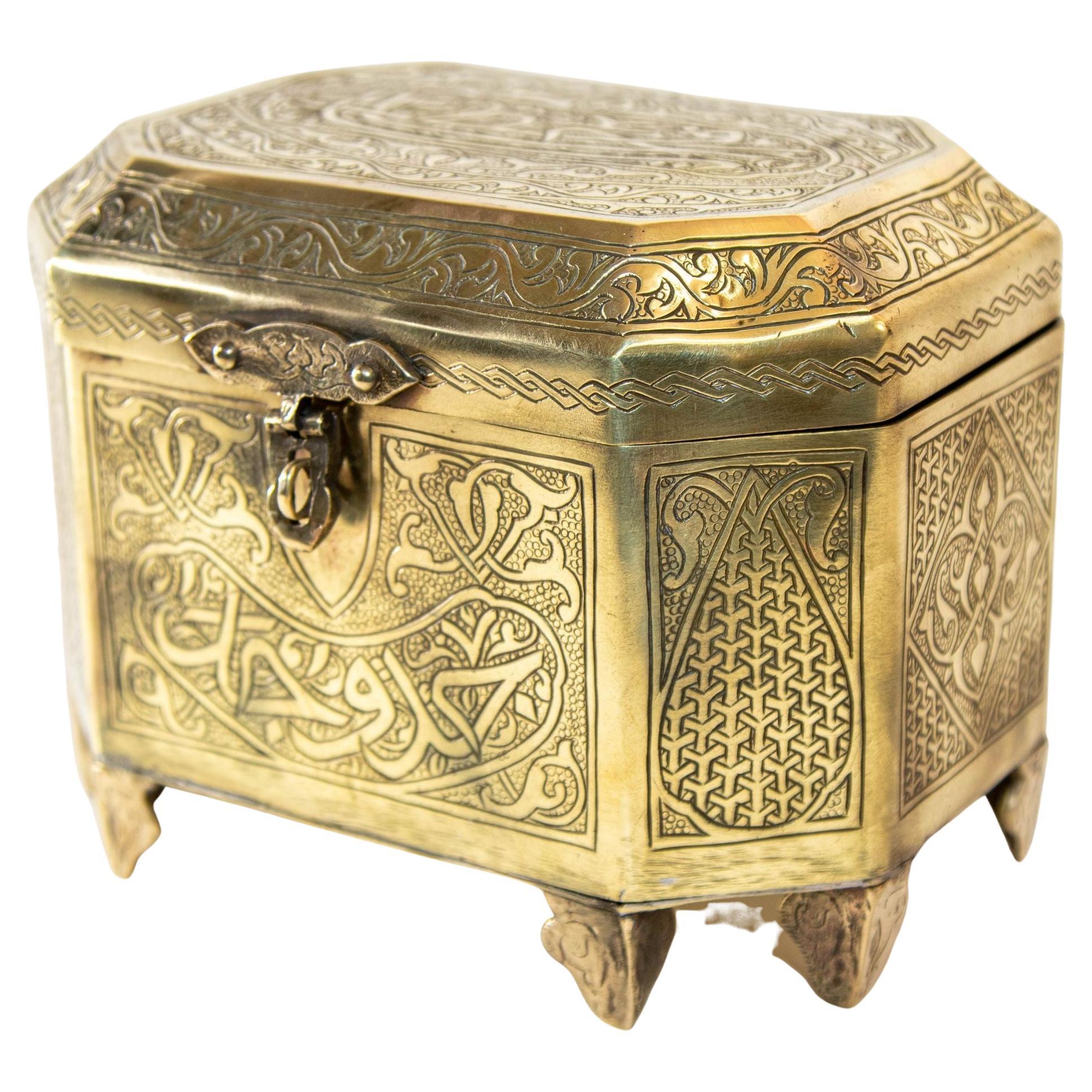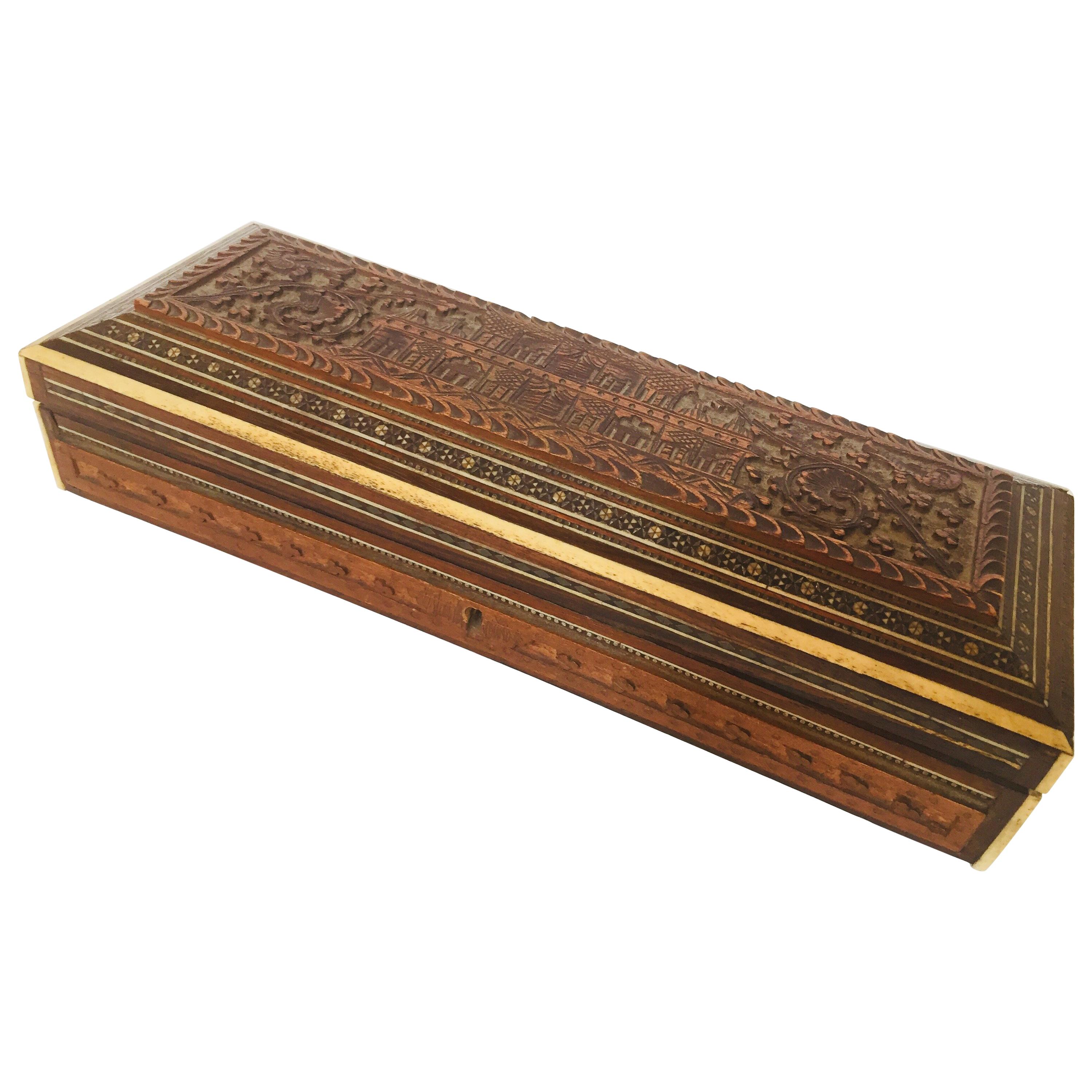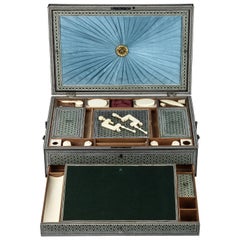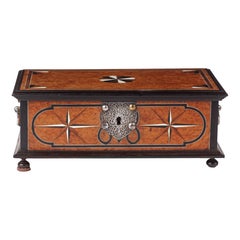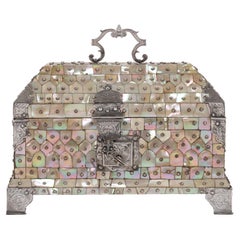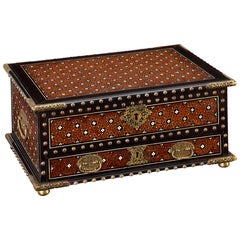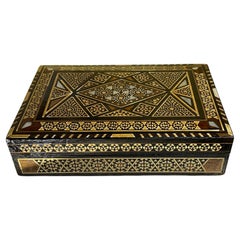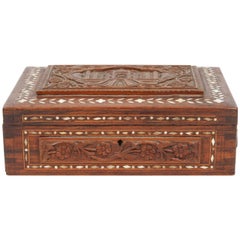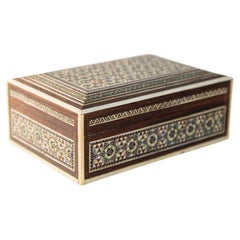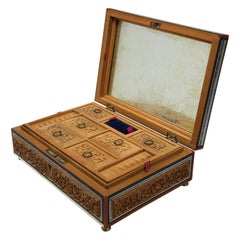Items Similar to Colonial Islamic Arabian Market Jewelry Box, 18th Century, India/Malabar Coast
Want more images or videos?
Request additional images or videos from the seller
1 of 3
Colonial Islamic Arabian Market Jewelry Box, 18th Century, India/Malabar Coast
$10,042.35
£7,527.36
€8,500
CA$13,796.48
A$15,402.47
CHF 8,070.66
MX$188,541.35
NOK 102,497.50
SEK 96,642.12
DKK 64,705.10
About the Item
AN INDIAN ROSEWOOD AND EBONY BRASS MOUNTED BOX FOR THE ISLAMIC MARKET
Malabar Coast, 18th century
With a large drawer with several compartments under a lid with two compartment interior, with brass mounts and chased brass decoration, including a key.
L. 26.4 x W. 19.5 x H. 12.3 cm
Note:
This type of box is usually described as a cash box but probably could be anything from a writing box to a jewellery box. It was not made primarily for the European market but rather for the Arabian and Persian markets.
- Dimensions:Height: 4.85 in (12.3 cm)Width: 10.4 in (26.4 cm)Depth: 7.68 in (19.5 cm)
- Style:Islamic (Of the Period)
- Materials and Techniques:
- Place of Origin:
- Period:
- Date of Manufacture:1700-1780
- Condition:Wear consistent with age and use.
- Seller Location:Amsterdam, NL
- Reference Number:1stDibs: LU5458220974672
About the Seller
5.0
Recognized Seller
These prestigious sellers are industry leaders and represent the highest echelon for item quality and design.
Established in 1985
1stDibs seller since 2020
23 sales on 1stDibs
Typical response time: 2 hours
- ShippingRetrieving quote...Shipping from: Amsterdam, Netherlands
- Return Policy
Authenticity Guarantee
In the unlikely event there’s an issue with an item’s authenticity, contact us within 1 year for a full refund. DetailsMoney-Back Guarantee
If your item is not as described, is damaged in transit, or does not arrive, contact us within 7 days for a full refund. Details24-Hour Cancellation
You have a 24-hour grace period in which to reconsider your purchase, with no questions asked.Vetted Professional Sellers
Our world-class sellers must adhere to strict standards for service and quality, maintaining the integrity of our listings.Price-Match Guarantee
If you find that a seller listed the same item for a lower price elsewhere, we’ll match it.Trusted Global Delivery
Our best-in-class carrier network provides specialized shipping options worldwide, including custom delivery.More From This Seller
View AllRare Complete Early 19th Century Indian Sadeli Work and Writing Box
Located in Amsterdam, NL
A rare complete Indian Sadeli inlaid work and writing box
British India, Bombay (present-day Mumbai), early 19th century
Micromosaic inlaid wood, with fitted bone interior and tools, and silver fittings.
H. 12.6 x W. 43.2 x D. 28.5 cm
Note:
Workboxes, portable writing desks...
Category
Antique Early 19th Century Indian More Asian Art, Objects and Furniture
Materials
Bone, Wood
A highly refined Dutch-colonial Sri Lankan inlaid box with silver mounts
Located in Amsterdam, NL
Galle district, 18th century
The box is made of amboyna burr with inlays of ebony, bone and burr wood and has several interior compartments, all made with the utmost attention to de...
Category
Antique 18th Century Sri Lankan Decorative Boxes
Materials
Bone, Ebony, Amboyna
16th-Century Indo-Portuguese Colonial Mother-of-pearl Gujarat Casket
Located in Amsterdam, NL
An exceptional Indo-Portuguese colonial mother-of-pearl veneered casket with silver mounts
India, Gujarat, 2nd half of the 16th century, the silver mounts Goa or probably Lisbon
Measures: H. 16 x W. 24.6 x D. 16.1 cm
An exceptional Gujarati casket with a rectangular box and truncated pyramidal lid (with slopes on each side and a flat top) made from exotic wood, probably teak (Tectona grandis), covered with a mother-of-pearl mosaic. The tesserae, cut from the shell of the green turban sea snail (Turbo marmoratus, a marine gastropod) in the shape of fish scales, are pinned to the wooden structure with silver ball-headed nails. The casket is set on bracket feet on the corners. The masterfully engraved decoration of the silver mounts follows the most refined and erudite Mannerist repertoire of rinceaux and ferroneries dating from the mid-16th century. The high quality and refinement of the silver mounts and, likewise, the silver nails that replaced the original brass pins used to hold the mother-of-pearl tesserae in place indicate the work of a silversmith probably working in Lisbon in the second half of the 16th century.
The Indian origin of this production, namely from Cambay (Khambhat) and Surat in the present state of Gujarat in north India, is, as for the last three decades, consensual and fully demonstrated, not only by documentary and literary evidence - such as descriptions, travelogues and contemporary archival documentation - but also by the survival in situ of 16th-century wooden structures covered in mother-of-pearl tesserae. A fine example is a canopy decorating the tomb (dargah) of the Sufi saint, Sheik Salim Chisti (1478-1572) in Fatehpur Sikri in Agra district in the state of Uttar Pradesh, north India. This is an artistic production, geometric in character and Islamic in nature, where usually the mother-of-pearl tesserae form complex designs of fish scales or, similar to the dishes also made using the same technique, with the thin brass sheets and pins, stylized lotus flowers. The truncated pyramidal shape corresponds, like their contemporary tortoiseshell counterparts also made in Gujarat, to a piece of furniture used in the Indian subcontinent within the Islamic world prior to the arrival of the first Portuguese. This shape, in fact, is very old and peculiar to East-Asian caskets, chests or boxes used to contain and protect Buddhist texts, the sutras.
A similar chest is the famous and large reliquary chest from Lisbon cathedral that once contained the relics of the city's patron saint, Saint Vincent. Both match in shape, having the same kind of socle or pedestal and bracket feet, and in their engraved silver mountings, featuring the same type of refined, erudite decoration. Their differences lie in the silver borders that frame the entire length of the edges of the chest (both the box and the lid), pinned with silver nails, and on the lock plate, shaped like a coat of arms in the Lisbon example. Given the exceptional dimensions of the reliquary casket...
Category
Antique 16th Century Indian Jewelry Boxes
Materials
Silver
An Indo-Portuguese bone-inlaid ebony and teak writing box with gilt-brass mounts
Located in Amsterdam, NL
India, Goa, 17th century
The box, overall inlaid with a delicate pattern in ebony and bone in teak reserves bordered by brass-studded ebony, is of oblong shape. The corners, lock-pl...
Category
Antique 17th Century Indian Cabinets
Materials
Bone, Ebony, Teak
An exceptional Namban 'escritório' writing-box, with a single drawer
Located in Amsterdam, NL
Kyoto, Late Momoyama to Edo period, circa 1590-1630
Decorated in pearl shell and gold with branches, leaves and flowers inside cartouches on a pearl shell mosaic background.
H. 25 ...
Category
Antique 17th Century Japanese Lacquer
Materials
Gold
Chinese 17th/18th Century Huanghuali Document Box with Baitong Mounts
Located in Amsterdam, NL
A Chinese Huanghuali document box with baitong mounts
Late Ming/Early Qing dynasty, 17th/18th century
H. 6 x W. 34.8 x D. 17.5 cm
Proven...
Category
Antique Late 17th Century Chinese Ming Furniture
Materials
Brass
You May Also Like
Middle Eastern Moorish Jewelry Box
Located in Delray Beach, FL
exquisite middle Eastern Moorish Syrian inlay jewelry box. This box is intricately inlaid with Moorish motif designs which have been uniquely inlaid with bone, mother of pearl and f...
Category
20th Century Asian Islamic Jewelry Boxes
Materials
Mother-of-Pearl, Sandalwood
19th Century Anglo-Indian Mughal Box
Located in North Hollywood, CA
19th century Anglo-Indian Mughal wood box, inlaid and hand carved with the Taj Mahal and some flowers all around.
Jewelry box, Anglo-Raj box from India in great condition.
Nice Mughal Bombay Box...
Category
Antique Late 19th Century Indian Anglo Raj Decorative Boxes
Materials
Sandalwood
Antique Decorative Middle Eastern Islamic Box 1940s
Located in North Hollywood, CA
Antique 1940s Mosaic Shell Inlaid Decorative Middle Eastern Islamic Box.
Mosaic Luxury Decorative Middle Eastern Islamic Vanity Box.
Middle Eastern Asian Mosaic Wood Box with Inlays ...
Category
Mid-20th Century Lebanese Moorish Decorative Boxes
Materials
Bone, Shell, Abalone, Fruitwood
Anglo-Indian Footed Box with Lidded Compartments, 19th Century
Located in North Hollywood, CA
19th century Anglo-Indian wooden box fitted with various compartments finely hand carved.
The top is finely hand carved with the Taj Mahal.
The interior with removable hand carved nine-lidded compartments, the front cover has a mirror, the whole exhibiting very fine workmanship.
This fine late Victorian Anglo-Indian box from India is in great condition for it age.
A beautiful example of an Anglo-Indian fine art...
Category
Antique Late 19th Century Indian Anglo-Indian Decorative Boxes
Materials
Sandalwood
1920 Persian Brass Jewelry Box in Mamluk Revival Damascene Moorish Islamic Style
Located in North Hollywood, CA
Antique Persian Islamic Brass Jewelry Footed Box in Mamluk Revival Damascene style.
A Middle Eastern Moorish Damascene Brass Box circa 1910-1920s.
A fine antique handcrafted etched hammered Syrian Damascene brass jewelry box.
Octagonal shape lidded antique Moorish Persian footed trinket brass box, handcrafted and chased with calligraphy Islamic Arabic design writing.
The Box decorated with etched Arabic inscription and lotus flowers with a very fine Arabesque design.
Middle Eastern jewelry brass box with eight small feet, hinged lid, lined in a Moroccan red velvet.
Great Moorish Mamluke Revival brass decorative Islamic metal art object.
Dimensions 6.75" W × 5" D × 5.25" H.
In the Mamluk Style (Mamluk Revival).
Origin: Middle East.
Date: Circa 1900-1920s.
Hand-hammered and engraved, this beautifully incised brass box Islamic...
Category
Early 20th Century Asian Islamic Decorative Boxes
Materials
Brass
Fine Antique Anglo Indian Bombay Inlay Box
By Rajhastani
Located in North Hollywood, CA
Fine antique Anglo-Indian hand carved wooden jewelry box inlaid.
Nice Indian Mughal pen box handcrafted in very fine Sadeli micro mosaic...
Category
Antique Late 19th Century Indian Islamic Decorative Boxes
Materials
Wood
More Ways To Browse
India Jewelry
Large Jewellery Box
Islam Furniture
Jewelry Box Key
Inlay Jewellery Boxes
Antique Indian Jewelry
18th Century Colonial Furniture
Colonial India
Arabian Antique
Persian Jewellery
Islamic Brass
Antique Jewelry Box With Key
Indian Jewelry Box
Malabar Furniture
India Rosewood
Brass Box India
Islam Jewelry
Rosewood Box Inlay
